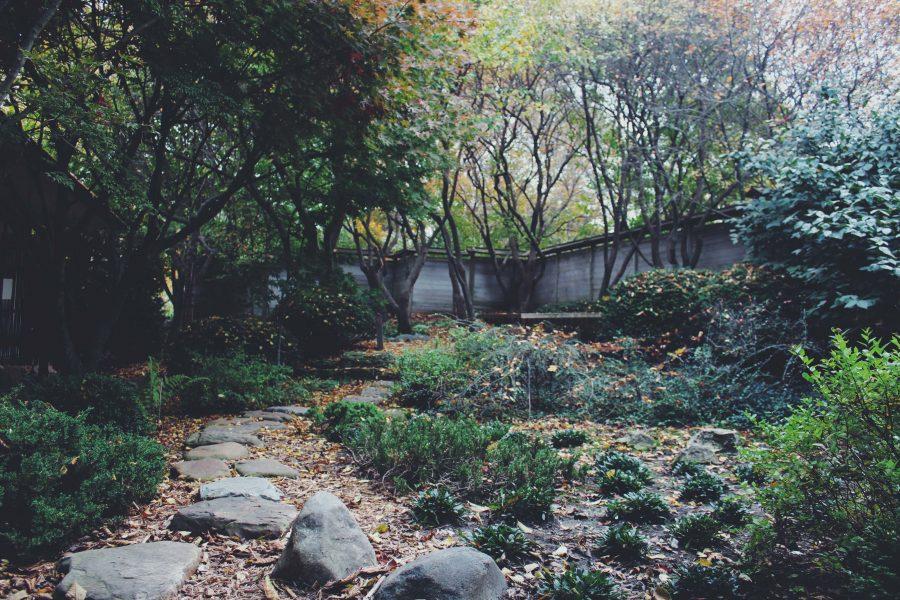March snow storm prevents cherry tree blossoming
The Japan House is celebrating the 20th anniversary at its permanent location with live performances and a Japanese temple festival.
Mar 26, 2017
February’s abnormally high temperatures brought ‘spring fever’ to students as well as plants, but those hopes for warmer weather were shot down by March’s cold temperatures.
If not for the winter storm in the second week of March, the cherry blossom trees in Sen Cherry Tree Allée at the University’s arboretum would have bloomed after February’s unseasonably warm weather.
“I don’t expect to have any trees really blooming. There may be a few blossoms here and there but nothing to take pictures of,” Jim Bier, designer and caretaker of the Japan House gardens, said. “I looked at the buds two weeks ago, and I predicted to people that in another week and a half they’d be opening up. And about a week after that, that’s when the storm came through, so I think they’re gone for the year.”
The cherry blossom trees, donated by Dr. Genshitsu Sen and Dr. and Mrs. Luting Liao in 2008, only blossom for about a week or so. Bier said the trees are designed for slightly warmer climates than Champaign-Urbana’s, so every year their blooming is a gamble.
Diane Anderson, grounds manager of the University’s arboretum, said when the buds advance before the temperature drops below freezing, they are not likely to blossom. She also said the cold temperatures are not harmful to the trees, but they do diminish their “beauty.”
Get The Daily Illini in your inbox!
Nathan Beccue, natural areas manager at nearby Allerton Park, said the plants in Allerton Park were not affected by the recent storm.
“Most of our early spring flowering plants are native and although some began flowering before the cold snap, they tend to weather the storm just fine,” Beccue wrote in an email. “Most of those species look fine now and I don’t anticipate a lingering effect from the cold spell.”
Unlike Allerton Park’s plants, cherry blossom trees are not native to the midwest. The trees are distributed around the Northern hemisphere in the temperate zones like India, West Siberia, Canada, Korea, China, Japan and Europe.
Cherry blossom trees prefer warm climates, so they face more challenges than other trees and plants. Many cherry trees were cultivated for ornamental use and do not produce fruit. Bier said the cherry tree is delicate and generally faces the same problems associated with fruiting trees like diseases and climate problems.
“The trouble is that cherry trees are more warm climate plants. They would do very good in Southern Illinois, but right here in Champaign-Urbana, they’re borderline,” Bier said.
Usually, cherry blossom tree blooming is surrounded by a series of events like festivals. In Urbana, the Japan House updates visitors on the progress of the blooming. It is not likely for these events to occur this year. Washington D.C., one of the only areas in the U.S. known for cherry blossom trees, also suffered from the cold snap with nearly half of the buds killed.
Bier said it only takes one day to ruin cherry blossom tree blooming, and that is the case with a lot of gardening.
Still, Anderson said there is much to look forward to in the arboretum. She said they are hoping to start a campaign to install more bulbs in all of the gardens. The arboretum, like the Japan House, thrives on donations.
“Everything that’s at Japan House has to be donated, and it doesn’t come from the University, so that’s a slow process,” Bier said. “We’re just maintaining what we have and trying to keep it in as good of shape as possible.”
Nick Offerman, well-known actor and University alum, helped design and build the “azumaya” (gazebo) in the arboretum in 2013. Offerman will visit on April 1 to host a fundraiser for the Japan House.
Even though the cherry trees will not be blossoming, visitors can look forward to some upcoming new additions.
“This spring we’re going to have flowering trees, a few shrubs, and herbaceous perennials that we’re going to plant in the next couple of months,” Anderson said. “We are also working on some benches . . . and we’re hoping to have some more artwork.”
The new additions are in celebration of the University’s sesquicentennial. The arboretum is adding a new garden straight east of the Master Gardener’s Idea Garden, as well as expansions around the Miles C. Hartley Selections Garden. The arboretum expects the additions to be completed by the end of summer.






